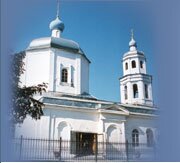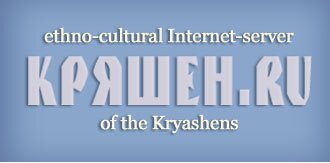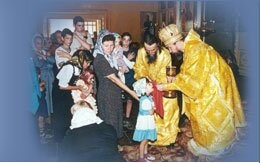Zhuravsky Alexander Vladimirovich
Vice-rector of the Kazan Theological Seminary,
Candidate of history, candidate of theology
TO THE QUESTIONS OF THE KRYASHENS' CONFESSIONAL BELONGING
Report at the conference:
"Ethnical and confessional traditions of the Kryashens: history and modernity" (7 th December, 2000)
There is more questions than answers in the history of the Kryashens. No doubt, that the Kryashens are Povolzhje Turks, whose culture and language are close to the Tatars˘ , but despite this similarity the Kryashens have remarkable ethno-cultural and anthropological peculiarities. One of them is that the Kryashens are mainly Orthodox Christians. Neither ethno-genesis nor time of the Kryashens˘ baptism nor many other aspects of the history of this nation are unknown. There is no even one opinion between scientists who the Kryashens should exactly be considered - ethno-confessional (D. Iskhakov), sub-confessional (§Tatar Encyclopedic DictionaryŠ, Kazan, 1998) group of the Tatars or even separate nation.
So, noting different groups of the Tatars˘ ethnos, famous (now, to great pity, the deceased) ethnologist Solomon Brook expressed (Encyclopaedia §The nations of RussiaŠ (1994); the article §Ethnic composition of the population of RussiaŠ) next thought: §There are required special research now in order to determine which groups from these groups are, indisputable, the part of the Tatar ethnos, but which ones have kept their isolation. In any case, so-called Siberia Tatars, but possibly the Nagabaiks, the Kryashens and some others have no lesser foundation to be considered as independent ethnoses than to be the part of the Tatarsň The unification of the ethnoses whose cultures and languages are close to each other into the bigger nations also causes doubt because it was being held in the 20-30 -ies by pressure of the power and very often against the will of these ethnic groupsŠ.
Which did role play the baptism of the Kryashens into Orthodoxy as a factor formed them as the nation; when was this baptism realized; how close is the ethnonym §The KryashensŠ related to the ethno-genesis of this community? We hardly will be able to answer these questions but at least we will try to select possible ways of their decisions.
Do we know something about baptized Turks before the 16 century ? Certainly. And it is very important that chronicle stories are completed by archeological research of the XX century.
In our opinion, which we had had possibility to bring to responsible scientific opinion at some Kazan conferences, it is possible to mark out five stages and five fundamental directions of the penetration of Christianity into the Middle Povolzhje Region:
1. Khazar-Alan period (VII-X centuries)
2. South-Russian period: the penetration of Christianity from Southern (Kiev) Russia (X-XI centuries)
3. Vladimirskiy period: the penetration of Christianity from Northern (Vladimir) Russia (XII century)
4. Golden Horde period (XIII-XV centuries)
5. Moscow period: the penetration of Christianity from North Northern (Moscow) Russia (XV-XXI centuries)
Since we have no time to examine all aspects of these periods, we will only mark the most important and the brightest from them. Christianity had been penetrating into Bulgaria in different forms (Nestorianism, Monophysitism, Orthodoxy, Catholicism). And no doubt, that in different time the greater or lesser number of the Turks of Povolzhje had been professing Christian faith.
According to the chronicle of Avraamka, prince Vladimir carried out the campaign against the Radimiches and the Bolgars in 997 After making the peace treaty between the Bulgars and prince Vladimir in 985, the Volga Bulgars tried to persuade the prince to adopt Moslem faith in 986. In 990 prince Vladimir sent to the Bulgars the missionary named Mark Makedonyanin with the proposal to accept baptism. How resultative was this mission? It is very difficult question. But it exists information that four Bolgar princes were baptized. And we know from history that the baptism was not only accepted by one person but all his household (kin) also did so. Thus the baptism of a prince almost always meant the baptism of his retinue and relatives. In 994 and 997 prince Vladimir carried out successful campaigns against the Volga Bulgars and the Kama Bulgars. And undoubtedly religious question was not ignored by this. At last in 1006, according to V.V. Tatishev, between prince Vladimir and the Volga Bulgars (initiative was come from the Bulgars) was made the treaty about free trade between the Russian and Bulgarian merchants (latter had some limitations). And, as we know, trade relations played an important role in the dissemination of religion.
From second half of the XII century till first quarter of the XIII century the active penetration of Christianity had been taking place out of Northern Vladimir Russia into Volga Bulgaria. So in 1164 Andrew Yuryevich Bogolyubskiy carried out the successful campaign against the Volga Bulgars, together with his son Izyaslav and his brother Yaroslav. The chronicle of Suzdal testifies, according to the Lavrentyev copy: §the Bulgars were killed in a great number and their flags were taken and hardly a prince of Bulgaria escaped with a small number of his army as far as Great city. Prince Andrew came back with the victory.Š The chronicles praise the prince not only for zeal in the construction of churches and monasteries but also for the conversion of many Volga Bulgars into Christianity. Characteristically that, according to the chronicle of Tver, prince Andrew Bogolyubskiy was married to a Volga Bulgaria woman. The archeological research testify about considerable presence of the free Christians (not slaves) in Volga Bulgaria exactly in the XII century. The finds belonging to this time are related to the Christian cult (a sacramental fan, a censer e.t.c.) Besides, one of the first Russian saints (who was honoured exactly in the Vladimir princedom!) was Avraamiy Bolgarskiy (the merchant from Volga Bulgaria, the native Bulgarman) the Christian martyr, who was tortured in 1229 by his one-tribal people, the Moslems, because he refused to deny Orthodoxy. The Archeologic researche found out that the Christians-craftsmen had been living for some centuries in Bulgars* but not only the Christian merchants, who had lived there constantly.
We can also adduce other chronicle and archeological testimonies. But which we have mentioned are enough, all the more that they only partly brighten up a picture. Only one thing is clear for us, that the Christians had been living in Volga Bulgaria at the before Horde time, at the Horde time and after Horde time. And what is more they weren˘t only the captives but also they were free people, and what˘s more they weren˘t only the Slavs but also there were the Christians-Turks, though their number is impossible to compare with the number of the Povolzhje Turks-Moslems. The antagonism of two beliefs-Islamic and Christian-could do nothing with rather complicated existence of the Turks-Christians in the Islamic surroundings, as history shows this. The preservation of many rudiments of pagan traditions in the Tatar culture testifies that Islam had to submit with the pagan traditions of great vitality. According to this thought the Turks-Christians, the Proto-Kryashens at bottom, were able to preserve themselves in the Islamic surroundings only in that case if they had been deviating into the paganism, which was closer to the Bulgars-Moslems than Christianity. This explains the number of the ethnographical (pagan) peculiarities of the way of life of some groups of the Kryashens, in that number the Molkeev Kryashens.
The language of the Kryashens is from the number of languages which weren˘t assimilated by the Tatar or Russian majority in the XX century. It keeps the number of serious differences (from the Tatar language) in itself, many of them were analysed in the research work by F.Bayazitova §The dialects of the Tatars-Kryashens in the comparative elucidationŠ. (M: Nauka, 1986) The language of the Kryashens is more anachronical in comparison with the Tatar language carrying in it self the traces of Islamic influence. By this, the divergences are revealed between the Tatar and Kryashen languages in some conceptions, which are taken as a principle and main for the religious life of people (love, baptism, miracle, the Scripture, Spirit, Teacher, disciple, Grace, the Truth, sin, the Law et.c.) And though F. Bayazitova characterizes the language of the Kryashens as a §dialectŠ, the Kryashens themselves aren˘t agree with it. It is important that the language of the Kryashens is deprived of the great linguistic layer of arabisms and persisms. This is the Turkic language which is feebly touched by Islamic influence.
It would be strange to consider that for 300 years ( if we count from the middle of the 16 century up to the middle of the 19 century when Ilminskiy began to study the language of the Kryashens) the language of the Kryashens was able to deprive of the whole layer of the vocabulary related to Arabian-Persian religious influence because of the activity of the Russian and Christian missionaries. There is no the evident traces of Islamic influence in this language, so a bearer of this language had been living rather for a long time (undoubtedly up to the 16 century) isolatedly from this influence in half-Christian, half-pagan condition. In this sense and martyr Avraamiy Bolgarskiy was from the environment of the Volga Bulgars - Christians, and what˘s more baptized long ago, so far as the chronicles don˘t say about him like about new - baptized (as it is said about the martyrs of the XVI century, martyrs St. Peter and St. Stephan of Kazan, who were out of the Tatars - Moslems. The chroniclers narrate about them like about §new-baptizedŠ).
It is to the point here to put the question about ethnonyms the §KryashensŠ and the §baptized TatarsŠ.
The aspiration to deny the distinction of the Kryashens leads to the paradoxical results. In the recently edited §Tatar Encyclopaedic DictionaryŠ, which obviously claims to the scientific authencity, it has got a reference placed to the article §the baptized TatarsŠ instead of the article §the KryashensŠ. By this the baptized Tatars are determined as the sub-confessional group of the Tatars, formed in the 16-18 centuries and subdividing itself into two subgroups - the old-baptized and new-baptized Tatars. But below, saying about the confessional belonging of the baptized Tatars, the authors of the article affirm that the baptized Tatars are mainly Orthodox people, i.e. mainly baptized (!). But if the confessional sign is put in the basis of the Kryashens˘ definition, solely determining the Kryashens as the subconfessional group, so the baptized Tatars are all baptized people but not §mainlyŠ. At the same time it is known, for the example, about existence so called un-baptized Kryashens among the Molkeev Tatars. So it impossible for the ethnonym § the baptized TatarsŠ to reflect the ethno-cultural originality of the Kryashens in a complete measure. Moreover people, insisting on the denomination of the Kryashens §the baptized TatarsŠ (And this idea is defended by some representatives of scientific intelligentsia) have just forgotten that the Tatars themselves rarely named themselves §the TatarsŠ even in the XIX century, but more often - §the MoslemsŠ, §the Kazans (Kazanli)Š, §the MisharsŠ. And only in the XX century the ethnonym Tatarman became the eyhnonym in general use. Where as §the KryashensŠ - it is the self denomination of the particular ethnoconfessional community and this right is to be respected.
Characteristically, that in spite of common negative attitude to the Christian missionary activity, the classification, elaborated by the Orthodox missionaries and naturally divided the Tatars according to the periods of their baptism (i.e. the old-baptized Tatars, who were baptized in the middle of the XVI century and the new-baptized Tatars, who were baptized in the XVIII century), has been borrowed by the modern Tatar science. It is to be noted that the Orthodox missionaries put in the basis of the classification not ethnical but a chronological sign. Thanks to the Orthodox missionaries, many nations of the Povolzhje Region had been given their own alphabet, their own ABC and literature, their own national intelligentsia, brought up in the Orthodox Seminaries had been prepared teachers.
Whereas it is obvious that such classification is conditional and it doesn˘t explain the ethnogenesis of the Kryashens, as the distinctive ethno-confessional community which, in our opinion, had been forming much earlier of the XVI century. Moreover, most probably, it is a question of the different ethno-confessional communities. The people, who are named §the old-baptized TatarsŠ, most probably, are the Kryashens, who were in pagan-Christian condition to the moment of the fall of the Kazan khandom. Because of this reason the baptism of this community had been going rather quietly and naturally. The Kryashens had simply been coming back to the half-forgotten Christian condition. Then it is understandable why the Kryashens were rather steady in faith. At the same time it is impossible to exclude that at this time the Tatars-Moslems came into the number of the people who were baptized in the 16 century. But just they fell off by the first possibility. We can express a supposition which, of course, requires to be confirmed, that under the fallen old-baptized people were exactly understand that people, who were baptized of a number of the Tatars-Moslems in the XVI century.
Who are the new-baptized Tatars? It˘s more clearly. These are the Tatars-Moslems, who practically all came back into Islam in the XIX century, especially in 1905-1906, when freedom of faith was given.
The language archaisms, the absence in the Kryashen˘s language of many arabisms and persisms, which are presented in the Tatar speech in abundance, testify on the one hand that the Kryashens are the bearers of the more archaic forms of the language and the way of life in comparison whith other groups of the Povolzhje Turks; and on the other hand they testify about the longstanding isolation of this ethnic community from the influence of Islam. Any of these reasons is enough to talk about the Kryashens as about the distinctive ethno-confessional community but not only as about the subconfessional group of the Tatars. At the same time even elementary anthropological research testify that and here the Kryashens differ from the most part of the Tatars. So, according to the research by T.A. Trofimov, which were realized in the 40-ies, the Kryashens have practically naught epicantus (the structure of the upper eyelid of eyes), the most growth of a beard in comparison with other groups of the Tatars, the most percentage of light hue of hair and a higher height.
The ethno-genesis of the Kryashens˘ has not been investigated but those people, who think that the beginning of the Kryashens formation as ethno-confessional community was in the XVI century, at the time of christianization of Povolzhje nations, make two important mistakes. Firstly it should not be forgotten that the united Tatar ethnos itself had only formed finally at boundary of the XIX-XX centuries, formed in result of the consolidation of the Volga-Urals, Astrakhan and Siberia Tatars. Moreover even A.Kh. Khalikov noted that the joining of the Kazan region to the Russian state §had progressive importance in the historical perspectiveŠ and it played an important role in the destiny of the Tatar nation because it promoted to §the national formation at the basis of the union of two main groups - the Kazan Tatars and the Tatars-MisharsŠ. So, even if the Kryashens formed in the XVI century, it would not have belittled their distinct. At secondly it is obviously at present time that in spite of all huge influence which the joining of the Kazan khandom to the Moscow kingdom exerted at the Kryashenss˘ formation, it is impossible to explain all the distinctive peculiarities of the Kryashens by their stay in Ortodoxy from the XVI century. A number of Tatar scientists are forced to be agree to it. In particular, D.M. Iskhakov, though with reservations, admits the adoption of Orthodoxy by the Kryashens in the XV century.
But all this doesn˘t change a common situation. The Kryashens as before stay little-investigated community.
|





